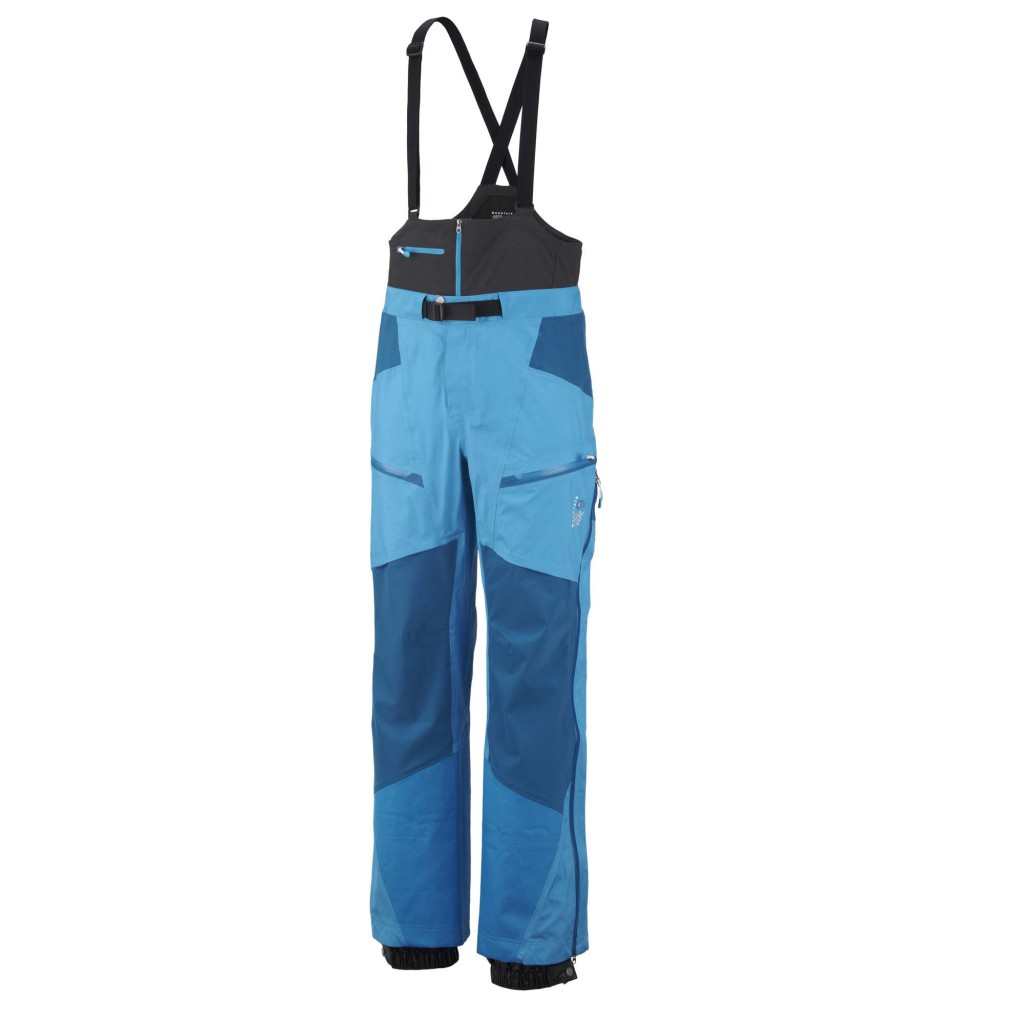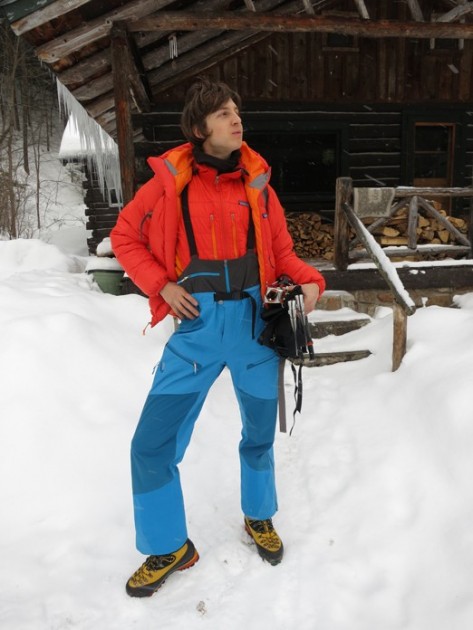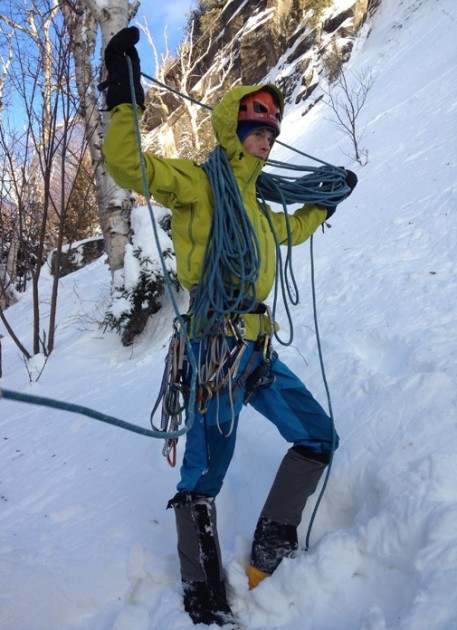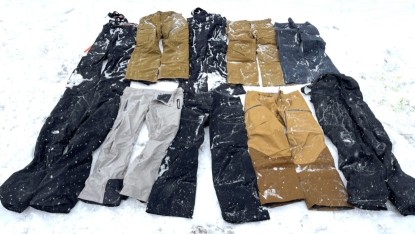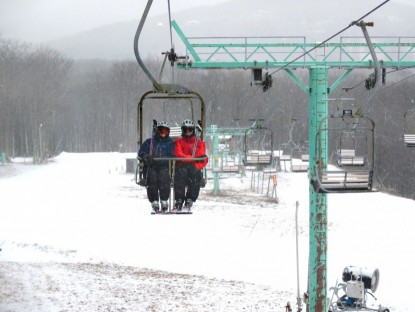Mountain Hardwear Drystein Pant Review
Our Verdict
Our Analysis and Test Results
Introduction
This review explores the advantages and disadvantages of various types of climbing pants and examines, in detail, the Mountain Hardwear Drystein bib. Testing for the Drystein was and continues to be done by the two primary authors on northern New England ice and alpine climbs.
What to Look for in a Climbing Pant
Bibs or pants? Waist high pants are ideal for any type of three-season climbing. Bibs that come partway up your chest greatly increase warmth by reducing convective heat loss at the pant-jacket-harness interface. When extending your arms all the way above your head, like we climbers tend to do, bibs help to keep the small of your back protected when a jacket rides up or comes untucked from a harness. Bibs offer significantly more warmth and weather protection than pants.
Softshell or hardshellSoftshell pants are ideal for high output activities in cold and dry conditions. Hardshells are warmer for their weight because they're completely windproof and waterproof and use thinner fabrics. Stretchy softshell pants can be more comfortable to climb in, depending on the fit and the type of baselayer you wear underneath. Our testers generally use hardshell bibs in alpine settings, on multi-day trips, or for ice cragging on warm drippy days. Softshell pants can be better for climbing hard water ice at a crag with a small approach and without alpine features like high winds.
Water resistance. Having climbed for many years in bibs that wouldn't even qualify as water resistant, we can say with confidence that waterproof bibs are a blessing. Despite your best intentions to climb ice, you will often find yourself surrounded by the liquid form of water. Melting ice can drip all over your thighs, glissading in snow can thoroughly soak your butt, and that dream snowstorm can turn into a rain monsoon. Precipitation that drips off your jacket often goes right onto your pants. Waterproof pants keep you drier.
Breathability. Slogging in deep snow and ice climbing go hand in hand. Wading through waist deep snow is an exhausting process to which your body responds by sweating. Single layer water resistant softshell fabrics are more breathable than three-layer hardshell fabrics with waterproof breathable membranes. However, recent advances in waterproof breathable technology are blurring the softshell-hardshell boundary and stronger, thinner face fabrics are more breathable than the thick and heavy fabrics found in the early and mid 2000s. Thus, hardshell bibs are getting ever more breathable and their waterproof and windproof properties often eclipse the need for a breathable fabric. Furthermore, ventilation is arguably more important than breathability.
Full sides zips. These are the key to proper ventilation. Unzipping even six inches helps to dump heat and moisture vapor faster than any highly breathable fabric could hope to. Side zips also allow you to quickly put on a pant layer without removing your mountaineering boots-- that's more than just a convenience. The zippers should both be manageable with awkward gloves as well as resist snagging on rocks, trees, and general krumholtz. Generally, softshell pants do not have full side zips and few companies make softshell bibs.
MobilityMobility depends on the fit of a pant and the amount of friction between your skin and the inside of the pant. Less friction is better because your legs slide quickly and easily within the pant. Choosing a slippery baselayer, like Patagonia Silkweight Capeline bottoms, helps to increase mobility. Adding stretchy softshell parts to a pant can also help.
Your pants must be roomy enough to accommodate several baselayers on very cold days. On the other hand, a baggy pair can be more than just an annoyance. In addition to looking goofy and containing unnecessary material, loose fitting bibs are much more likely to catch the various sharp metals instruments one brings while ice climbing. Even with your bibs tucked into your gaiters, eventually you will puncture the shell material with your spiky crampons.
Reinforcement. When ice climbing, the most vulnerable areas of bibs are the inner calves and outer thighs. The inner calf area will be stabbed by crampons and the upper thighs skewered by the ice screws dangling on your harness. Reinforcing materials, such as Keprotec, is heavier and less breathable, but keeps your bibs in one piece for longer. No bib or pant that we know of has reinforced upper thighs. Ice screw skewering can be mitigated to some degree by positioning Ice Clippers farther back on your harness.
Insulation. No hardshell climbing pant we know of is insulted. Some softshell pants, like the Outdoor Research Lodestar, have substantial insulation and others, like the Patagonia Guide Pant, have a lightweight brushed backer that adds considerable warmth. Uninsulated pants are more versatile and therefore a better value than insulated pants. For example, we are not likely to take an insulated pant on a multi-day climb.
Pockets, shoulder straps, fly. Outdoor companies spend years refining these obvious details, though they are not as important as the aforementioned features. Though these things should function well, it is important to keep an element of simplicity in bibs. When you're shivering in high winds well above treeline, you should not be forced to undo straps, snaps, velcro, and numerous zippers simply to get your bibs on or off. Pockets are useful for storing small and light objects like a topo, but they make any pant or bib uncomfortable when stuffed with large and/or heavy things. Unfortunately, full size zips eliminate the possibility of adding a side thigh pocket, which we believe is the best location for a pocket. Many climbing bibs add small pockets to the top bib section that lies above the waist. This has the added benefit keeping contents warmer, but is also less accessible. We rely primarily on our jackets for storage.
Butt zip. Sometimes you need to poop in the alpine. This simple feature is a very nice luxury, particularly when paired with a fleece bib with a butt zip. We highly recommend this combination.
Mountain Hardwear Drystein Pant Review
Wind and Water Resistance
The Drystein bib uses Mountain Hardwear's DryQ Elite waterproof breathable membrane. As membranes go, this one is thin and highly breathable yet also completely wind and waterproof. Combined with a relatively thin face fabric this bib is likely to score on the more breathable end when compared to other more durable bibs with thicker membrane and fabrics.
Mobility
A key feature that sets the Drystein apart from other bibs is its use of softshell fabrics. The knees and butt area use a stretchy face fabric that makes the bibs slightly more comfortable than those without the stretchy bits. Though the fit is a tad baggy for chicken legs, they will readily accommodate anything one could wear underneath. People will thick legs will want to size up.
Durability
Based on testing more than fifty hardshell and softshell jackets we suspect that the Drystein pants are not as durable as others we have yet to test. They are designed for mobility rather than absolute durability; these are climbing pants, not all-purpose winter work pants for skiing, snowmobiling, etc. More durable mountain pants would have a reinforced butt and knees, and a burlier face fabric.
Features
These pants have a lot of frills. There's a fixed elasticized waist band and two snaps at the top of the fly. You have to undo both in order to get out. The redundancy is unnecessary in our opinion, especially considering that the waist closure isn't used to hold the pants up. The thigh pockets are useful for a topo but make the pants uncomfortable if stuffed with anything thick or heavy. The shoulder straps, which provide support for the pants, are wonderfully comfortable. The butt zip is marvelous and the side zippers allow you to vent on the go.
The fly zipper should extend considerably farther down. Any climber knows that one must wear their pants high to allow for a full range of motion of the legs. One tester says, “When I wear these bibs high enough to allow my legs freedom, I cannot easily pee. I'm forced to hunch over, pull my penis way up toward my belly button, and barely get the tip past the bottom of the open fly before I can let loose.”
The built in gaiters are not sufficient protection for extended post hole sessions. We believe this feature is unnecessary for climbing because we almost always wear gaiters. The exterior side zip doesn't have a snap closure at the bottom cuff like other climbing pants do. This could be a drawback if one were to wear the pant without gaiters because the zipper could break if the side of your boot were to hit a rock or other hard object. Wearing gaiters helps to protect this area.
Style
The bright blue color makes a great first impression. Women will see you as a fun-loving free-thinking ice poet, instead of the insecure gear head you really are.
Weight and Packed Size
We haven't tested enough bibs to give a detailed analysis for weight and packed size. But, in general, hardshells are lighter and more compact than softshell pants. At 22 oz., these appear to be roughly on par with other bibs. Cutting off the built-in gaiters and unnecessary waist strap could save an ounce or two.
Best Application
Ice and alpine climbing.
Value
Without testing a suite of other bibs it's hard for us to confidently comment on value. $450 is a lot of money and other bibs are likely to be more durable over the long-term. We've found that these bibs perform very well for climbing and we suspect that they are a good value if you have the cash to push the performance envelope.
Other Versions
There's a Women's version, too!


